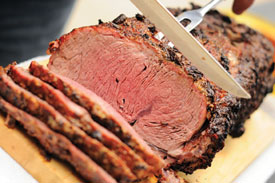Although many food items now come precut, and the use of processing machines that quickly cut and slice vegetables, cheese and other ingredients is more commonplace, one would be hard-pressed to find a commercial kitchen that does not contain some form of cutlery.
 Cutlery is an important commercial kitchen staple that can directly impact the production and presentation of food. Proper and precise cuts also directly affect portioning and, as a result, an operation's bottom line. When specifying the appropriate knives for use in a foodservice operation, key points of consideration include the size, shape, blade and type of edge in relation to the task.
Cutlery is an important commercial kitchen staple that can directly impact the production and presentation of food. Proper and precise cuts also directly affect portioning and, as a result, an operation's bottom line. When specifying the appropriate knives for use in a foodservice operation, key points of consideration include the size, shape, blade and type of edge in relation to the task.
It is common for some high-end foodservice operations to purchase house knives from equipment and supplies dealers. In some cases, sous chefs and line cooks will have their own sets of knives they bring on site for their personal use. That's because in the foodservice industry, knives are considered important tools of the trade, similar to a hairdresser's shears, which provide a familiarity and comfort level to perform efficient slicing, cutting and chopping.
Knives come in an assortment of lengths, widths and shapes for specific tasks. Chef's, paring and utility knives represent the three most common units utilized in a foodservice operation. There also are knives specifically designated for boning, slicing, skinning, peeling, spreading, bread slicing, fileting and carving, among other tasks.
Standard chef's knives are the most common and, like butcher's knives, range in size from 6 to 12 inches in length. Paring knives are shorter and average between 3 and 4 inches long, while slicing knives measure longer at between 8 and 14 inches.
Cutting knives include cutlery used for paring, boning and slicing. Culinary staff can use chef's knives for a variety of tasks, from light chopping to dicing. A utility knife is a hybrid that staff can use to perform a range of tasks.
While in the past, the majority of knives used have been Western style or German, now there is a movement toward Japanese style sushi knives and cleavers. This includes hybrid types that combine a Western handle and shape with a Japanese-style steel and grind that provides a different type of cut.
One of these newer knife types that has become more common over the last five years is the Santoku from Japan. This is a cross between a chef's knife and cleaver. Typically measuring seven inches long, foodservice professionals most commonly use this knife for chopping vegetables.
Bread knives and offset serrated sandwich knives, staples in sandwich shops and bakeries, work best with softer items, including bread, sandwiches and tomatoes. Scalloped blades have a dual edge with small indentations ground into the blade. This design creates suction for easier carving of warm meats. Knives with hollow ground edges provide thinner cutting.
For operations preparing meat in-house, staff typically use boning knives for meat production, including trimming fat off of chicken, beef and pork.



